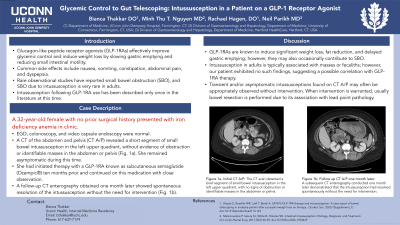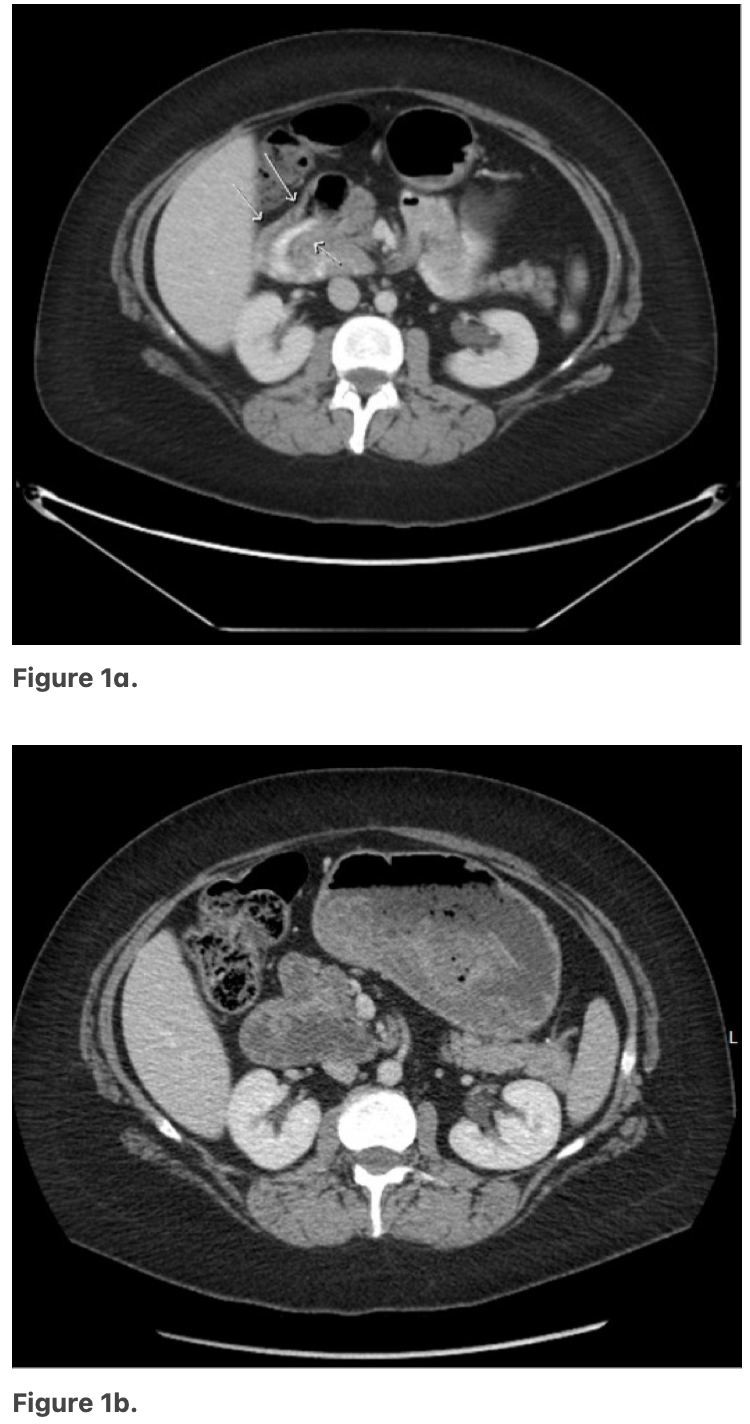Sunday Poster Session
Category: Small Intestine
P1549 - Glycemic Control to Gut Telescoping: Intussusception in a Patient on a GLP-1 Receptor Agonist
Sunday, October 27, 2024
3:30 PM - 7:00 PM ET
Location: Exhibit Hall E

Has Audio

Bianca Thakkar, DO
University of Connecticut Health Center
Farmington, CT
Presenting Author(s)
Bianca Thakkar, DO1, Minh Thu T.. Nguyen, MD1, Rachael Hagen, DO2, Neil D.. Parikh, MD3
1University of Connecticut Health Center, Farmington, CT; 2University of Connecticut Health, Farmington, CT; 3Hartford Hospital, Harford, CT
Introduction: Glucagon-like peptide receptor agonists (GLP-1RAs) effectively improve glycemic control and induce weight loss by slowing gastric emptying and reducing small intestinal motility. Although generally well-tolerated, common adverse effects include vomiting, constipation, abdominal pain, and dyspepsia. Rarely, observational studies have reported instances of small bowel obstruction (SBO) as a side effect. SBO due to intussusception, where one bowel segment folds into another, is extremely rare in adults. We report a unique case of a patient developing intussusception following treatment with a GLP-1RA, a phenomenon previously documented only once in the literature.
Case Description/Methods: A 32-year-old female with no prior surgical history presented with iron deficiency anemia in the outpatient setting. Following unremarkable results from esophagogastroduodenoscopy (EGD), colonoscopy, and video capsule endoscopy, she underwent a contrast-enhanced computed tomography (CT) scan of the abdomen and pelvis. Incidentally, the CT revealed a short segment of small bowel intussusception in the left upper quadrant without evidence of obstruction or identifiable masses in the abdomen or pelvis (Fig. 1a). The patient was asymptomatic throughout and after the imaging; therefore, she was managed conservatively with observation. She had initiated therapy with a GLP-1RA known as subcutaneous semaglutide (Ozempic®) ten months prior, and she continues on this medication. A follow-up CT enterography performed one month later showed spontaneous resolution of the intussusception without requiring intervention (Fig. 1b).
Discussion: This rare case underscores the importance of understanding potential adverse effects associated with the increasingly popular GLP-1RAs. While these medications are known to induce significant weight loss, fat reduction, and delayed gastric emptying, they may also occasionally contribute to small bowel obstruction (SBO) and, uncommonly, intussusception. Intussusception in adults is typically associated with masses or fecaliths; however, our patient exhibited no such findings, suggesting a possible correlation with GLP-1RA therapy. Vigilant monitoring for gastrointestinal complications is crucial for prompt intervention and management. Fortunately, in our case, our patient experienced resolution of her asymptomatic intussusception without requiring direct interventions despite continuing the medication.

Disclosures:
Bianca Thakkar, DO1, Minh Thu T.. Nguyen, MD1, Rachael Hagen, DO2, Neil D.. Parikh, MD3. P1549 - Glycemic Control to Gut Telescoping: Intussusception in a Patient on a GLP-1 Receptor Agonist, ACG 2024 Annual Scientific Meeting Abstracts. Philadelphia, PA: American College of Gastroenterology.
1University of Connecticut Health Center, Farmington, CT; 2University of Connecticut Health, Farmington, CT; 3Hartford Hospital, Harford, CT
Introduction: Glucagon-like peptide receptor agonists (GLP-1RAs) effectively improve glycemic control and induce weight loss by slowing gastric emptying and reducing small intestinal motility. Although generally well-tolerated, common adverse effects include vomiting, constipation, abdominal pain, and dyspepsia. Rarely, observational studies have reported instances of small bowel obstruction (SBO) as a side effect. SBO due to intussusception, where one bowel segment folds into another, is extremely rare in adults. We report a unique case of a patient developing intussusception following treatment with a GLP-1RA, a phenomenon previously documented only once in the literature.
Case Description/Methods: A 32-year-old female with no prior surgical history presented with iron deficiency anemia in the outpatient setting. Following unremarkable results from esophagogastroduodenoscopy (EGD), colonoscopy, and video capsule endoscopy, she underwent a contrast-enhanced computed tomography (CT) scan of the abdomen and pelvis. Incidentally, the CT revealed a short segment of small bowel intussusception in the left upper quadrant without evidence of obstruction or identifiable masses in the abdomen or pelvis (Fig. 1a). The patient was asymptomatic throughout and after the imaging; therefore, she was managed conservatively with observation. She had initiated therapy with a GLP-1RA known as subcutaneous semaglutide (Ozempic®) ten months prior, and she continues on this medication. A follow-up CT enterography performed one month later showed spontaneous resolution of the intussusception without requiring intervention (Fig. 1b).
Discussion: This rare case underscores the importance of understanding potential adverse effects associated with the increasingly popular GLP-1RAs. While these medications are known to induce significant weight loss, fat reduction, and delayed gastric emptying, they may also occasionally contribute to small bowel obstruction (SBO) and, uncommonly, intussusception. Intussusception in adults is typically associated with masses or fecaliths; however, our patient exhibited no such findings, suggesting a possible correlation with GLP-1RA therapy. Vigilant monitoring for gastrointestinal complications is crucial for prompt intervention and management. Fortunately, in our case, our patient experienced resolution of her asymptomatic intussusception without requiring direct interventions despite continuing the medication.

Figure: Figure 1a. The CT scan detected a brief segment of small bowel intussusception in the left upper quadrant, with no signs of obstruction or identifiable masses in the abdomen or pelvis.
Figure 1b. A subsequent CT enterography conducted one month later demonstrated that the intussusception had resolved spontaneously without the need for intervention.
Figure 1b. A subsequent CT enterography conducted one month later demonstrated that the intussusception had resolved spontaneously without the need for intervention.
Disclosures:
Bianca Thakkar indicated no relevant financial relationships.
Minh Thu Nguyen indicated no relevant financial relationships.
Rachael Hagen indicated no relevant financial relationships.
Neil Parikh indicated no relevant financial relationships.
Bianca Thakkar, DO1, Minh Thu T.. Nguyen, MD1, Rachael Hagen, DO2, Neil D.. Parikh, MD3. P1549 - Glycemic Control to Gut Telescoping: Intussusception in a Patient on a GLP-1 Receptor Agonist, ACG 2024 Annual Scientific Meeting Abstracts. Philadelphia, PA: American College of Gastroenterology.
